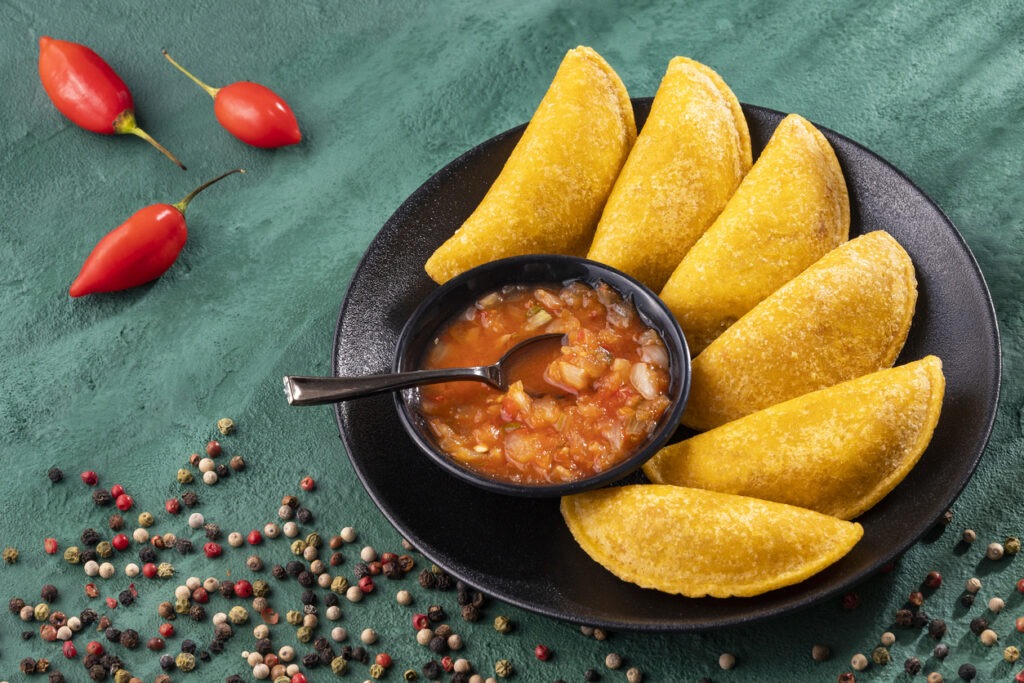The Spanish word “empanar,” which means “to bread” or, in the context of the empanada, “to wrap something in bread,” is where the word “empanada” originates. In essence, empanadas are stuffed bread. The simplest and most popular kind is filled with baked meat (either ground or finely minced), onions, one whole or half of a hard-boiled egg, and a few olives.
Three elements must be present for an empanada to qualify as such: dough, filling, and cooking technique. It differs from country to country whether an empanada is a flat half-moon or a three-dimensional half-moon.
There are also smaller baked or fried variants that can be utilized as finger appetizers at cocktail events, a partner for your morning coffee, afternoon snacks, or anything in between.
Different Variations of Empanadas

Before empanadas became a regional dish within Mexico, they were always made of maize dough, deep-fried, and filled with ingredients like pumpkin, sweet potato, or apple. Originally, they had a sweet filling.
Savory empanadas with ingredients like cheese and ham, chicken, mushrooms, minced beef, and raisins are popular in Argentina.
Colombian empanadas are large, superb pastries stuffed with rice, egg, cilantro, fried potatoes, and meat, chicken, or pork that has been spiced. Deep-fried to perfection, they are created from golden maize dough.
Empanadas from Chile are made from dough made from wheat and filled with ground beef, onion, hard-boiled egg, olives, and raisins. It’s typically baked.
Around Central America and in the Andes, people enjoyed delicious empanadas de viento, filled with fried cheese, and empanadas de verde, filled with plantains. It’s a vegetarian variation of the empanada.
The most basic dish in the Philippines will be filled with ground meat (pork, chorizos or chicken), raisins, green peas, corn, potatoes, carrots, and seasonings. It is typically fried. Each region has its own regional empanada that may contain longganisa, egg, or sayote.
Chinese-style empanadas called Jiucai Hezi have chives, morel mushrooms, mung bean rice vermicelli, garlic, and eggs. It is typically consumed to mark the Chinese New Year.
Depending on the country, empanadas and their near relative, empanadillas, come in a variety of various flavors and, like all dishes, are rather tasty when prepared properly. Different fillings, crusts, and decorative seals are used in regional variations.
What Are the Two Methods for Preparing Empanadas?
1. Baking
Some bakers and regions preferred baked empanadas. The process involves preheating the oven to 400 degrees Fahrenheit and baking the dough for 25 to 35 minutes. Some people prefer it gently toasted or golden brown.
2. Deep Frying
Empanadas are frequently fried in oil. It is deep-fried at 360 degrees Fahrenheit for seven minutes, or until golden brown. The crust’s crispiness comes from deep frying.
What Types of Flour Are Used in The Dough for Empanadas?
1. All-Purpose Flour
Different types of flour can be used to make empanada dough, but all-purpose flour is the most popular. Because it has less gluten and less protein, the resulting crusts are lighter and shorter.
2. Bread Flour
Although it will produce a denser dough, bread flour can be used to make empanada dough. In comparison to other forms of flour, bread flour is thought to be the strongest and contains 12–14% protein. It gives the dough a chewy and airy texture while also making it more elastic and light.
3. Glutinous Rice Flour
Using glutinous rice flour results in a softer, chewier, and more elastic dough. Due to the abundance of sticky rice flour in the region, certain Philippine empanada variations use this as base.
4. Corn Flour
Corn flour is used to create empanadas because it has a fine texture that leads to a smooth dough and does not contain gluten.
5. Rice Flour
Rice flour crisps and browns empanadas considerably more readily, plus it has no gluten. Because of the use of rice flour, Ilocano empanadas have a thin and crispy crust.
Empanada Dipping Sauces
Empanadas would also be delicious if served with a sauce that complements their flavor.
1. Chimichurri Sauce
Chimichurri sauce is a dip comprised of parsley, garlic, oregano, olive oil, lemon juice, vinegar, and crushed red pepper. Famous in Uruguayan, Nicaraguan, and Argentine cuisines.
2. Sriracha Sauce
Sriracha is a spicy sauce produced from jalapeno pepper paste, distilled vinegar, garlic, sugar, and salt. The sauce is mildly spicy.
3. Aji de Mani (Peanut Spicy Sauce)
Aji de Mani sauce is a traditional Colombian peanut spicy sauce. It contains peanuts, hot peppers, green onions, cilantro, tomato, and chicken broth.
4. Creamy Pineapple-Lime Dipping Sauce
The Creamy Pineapple-Lime dipping sauce is prepared using light mayonnaise, pineapple, and lime juice.
5. Apricot Dijon Dipping Sauce
This quick and easy sauce has 580 calories. It’s created with apricot, mustard, and red pepper flakes.
Conclusion
It is really simple to make your own empanadas. The difference is mostly determined by the filling. Savory or sweet options are available. They can be eaten as an appetizer, a full meal (due to the presence of carbohydrates, veggies, and protein), or a snack. Depending on how you make them, they can be large or small, healthy or not.